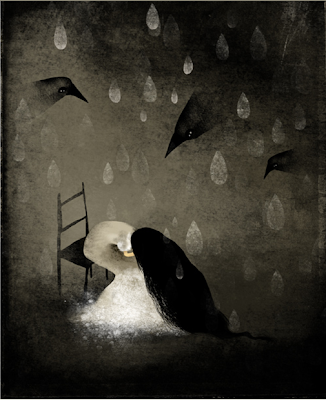
I have become a great aunt. A child came into this world only days ago and stretched the branches of our family tree, unknowing, barely seeing, warm and safe. I have never been married or had a child, but I stand by in amazement and wonder each time it happens in my family or with my friends. This afternoon I watched my family-- and the other sets of great grandparents, grandparents, aunts and uncles-- gather in a house this child will grow up in, awkward moments and silences eased by watching the baby do anything--cry, sleep, stare into my eyes or someone else's. I watched my parents move and react warmly to others and one another, and wondered in my own quiet mind if they used the same gestures with me when I was a baby, or if years and wisdom have just softened them to become the people I see across the room.
As I held this baby I wondered for her if her life would be peaceful and joyous, or stormy and uncertain, and wished deeply for the former.
I wonder if any two people know as they bring this life into the world, the real and beautiful responsibility of what they have created, the burden they must bear, the future they begin building as that child draws its first breath. There is such a clean slate in these first days and weeks.
I wonder if almost all births bring this moment, this out of focus optimism that emanates from this new being. It seems powerful enough--that given whatever outside rivalries, dangers, or broken histories--they can all lie in wait for these first moments--put aside for another time, another day, and in some cases, forgotten altogether by the magic of this new life.
But it is the mystery of it all that I wander through tonight, wishing for the technology of today when I was the new being, wishing video cameras were in every hand as they are now, so I could look back and see--not remember--but see from the future--me, there in the center of whatever mood filled the room, seeing myself in the place I started from.
I wonder if I had those moments on film if it would all seem foreign and disconnected, warm and familiar, or if there would be any small moments that could answer questions I have today.
And in some ways, maybe it is better to not have the time captured on film, to think instead that like all babies, I was a new life that connected a family, even for a few moments.
The poem below by Sharon Olds has always been so powerful to me, I discovered it in Anne Lamott's book for writers
Bird by Bird.
I Go Back to May 1937
by Sharon Olds
I see them standing at the formal gates of their colleges,
I see my father strolling out
under the ochre sandstone arch, the
red tiles glinting like bent
plates of blood behind his head, I
see my mother with a few light books at her hip
standing at the pillar made of tiny bricks with the
wrought-iron gate still open behind her, its
sword-tips black in the May air,
they are about to graduate, they are about to get married,
they are kids, they are dumb, all they know is they are
innocent, they would never hurt anybody.
I want to go up to them and say Stop,
don't do it--she's the wrong woman,
he's the wrong man, you are going to do things
you cannot imagine you would ever do,
you are going to do bad things to children,
you are going to suffer in ways you never heard of,
you are going to want to die. I want to go
up to them there in the late May sunlight and say it,
her hungry pretty blank face turning to me,
her pitiful beautiful untouched body,
his arrogant handsome blind face turning to me,
his pitiful beautiful untouched body,
but I don't do it. I want to live. I
take them up like the male and female
paper dolls and bang them together
at the hips like chips of flint as if to
strike sparks from them, I say
Do what you are going to do, and I will tell about it.
Read more...

























